Theory of macropore-formation of silicon in hydrofluoric acid |
|
| Short historie of macropores in
silicon |
|||
| In 1990 Lehmann and Föll (J. Electrochem. Soc., 137, 653 (1990))discovered that very regular arrays of macropores with extremely large aspect ratios could be obtained in the n-Si/HF system. They explained the formation of these pores on the base of a so-called "space charge region" model, assumes that the back-side photogenerated current is focused on pore tips because of the bending of the space charge region around the tip. The model certainly is valid for the formation of macropores in n-type Si, especially for the regular pore arrays, because based on this model and additional empirical results it is possible to produce pore structures as desired by Lehmann (J. Electrochem. Soc., 140, 2836 (1993) and V. Lehmann, U. Grüning, Thin Solid Films, 297, 13-17 (1997)). The model accounts quantitatively for macropore diameters in n-type Si with prestructured nuclei. 1994 macropores on p-type-silicon were found by Propst and Kohl (J. Electrochem. Soc., 141, 1006 (1994)) by anodic etching in an HF containing organic electrolyte (hydrofluoric acetonitril). | |||
| Scales for macropore
formation |
|||
| There are several length scales that may influence the system dynamics. To name just a few (with very rough numbers): quantum wire effects (nm scale), avalanche break-through (10 nm scale), space charge region (10 nm - 10 µm), Helmholtz layer thickness (nm), stability of diffusion (µm - cm). "Perfect" macropores are achieved if the dominating length scales are similar, complicated morphologies result if they are incompatible. | |||
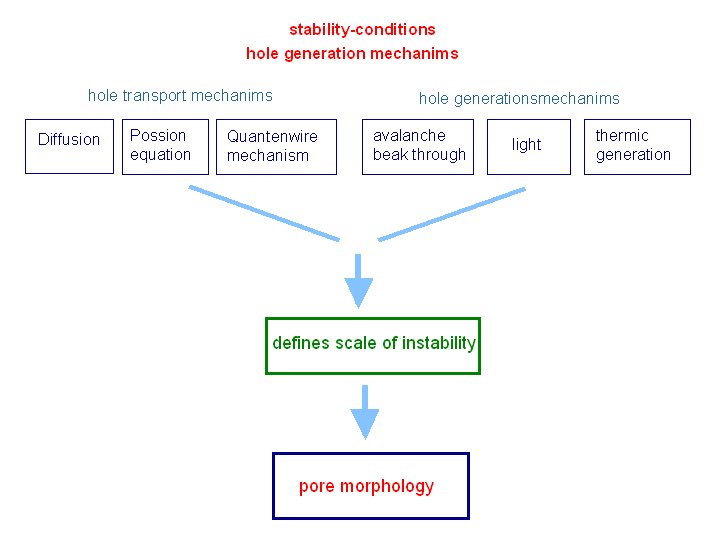 |
|||
| We are introducing a intrinsic time constant to the system. This us defined by the local current burst - the local reaction at the pore tips. In particular, the very long time constant of oxide dissolution is the decisive factor for the large length scales of macropores. | |||
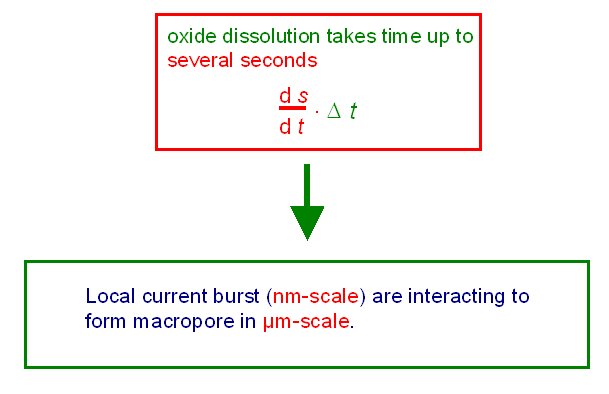 |
|||
| The reactions at the
macropore-tips |
|||
| The important fact is that current-flow is inhomogenious in time and space. Serval chemical and electrochemical reaction are important for the macropore-formation - schematic shown in the figure. | |||
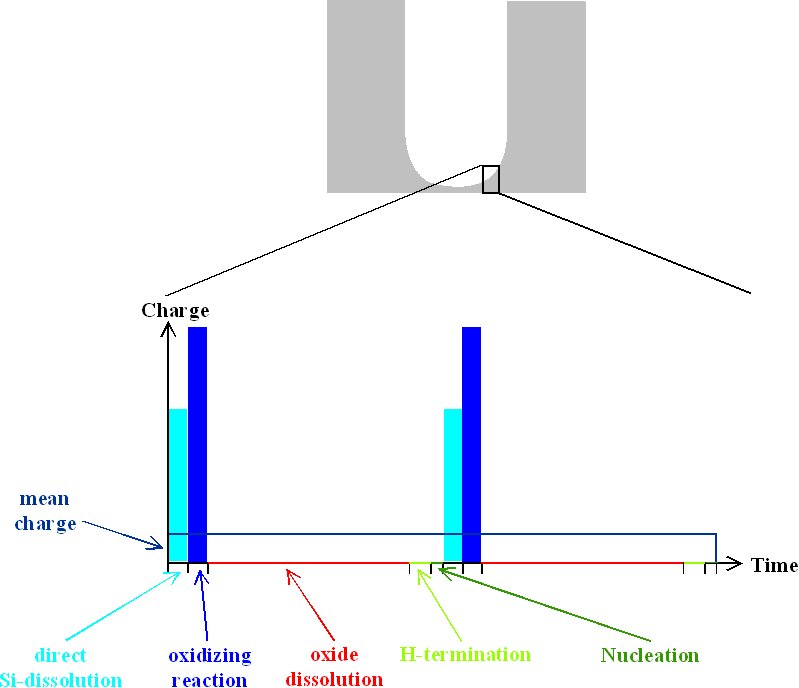 |
|||
| The local reactions has got different properties - see table below. | |||
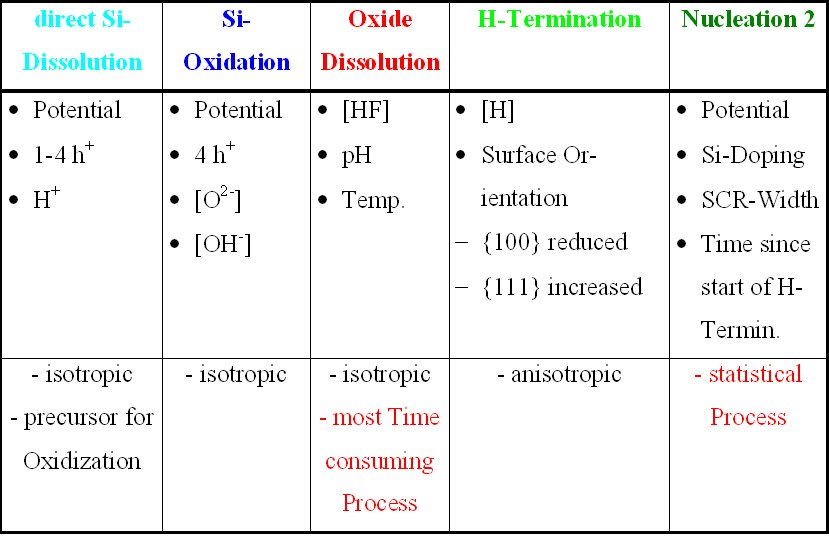 |
|||
| The importent reaction for macropore-formation is the H-termination/passivation of the silivon-surfaces | |||
| Macropore formation in p- and n-type silicon is an anisotropic process. The anistropic nature can be explained in the current burst model with theanistropic passivation process of the pore walls. The H-passivation is a kinetic anisotropic process. Correlation in space is produced by interactions in time which means that the nucleation probability of a current burst depends on what happened before. Since the nucleation probability is larger for smaller degrees of H-passivation, and H-passivation in turn is minimal on the {100} sur-faces just after the oxide is removed, there is an automatic coupling of new current bursts to old ones in the "pore regime" (i.e. whenever free Si surface is present) - the interaction in time is an intrinsic feature current burst model. | |||
 |
|||
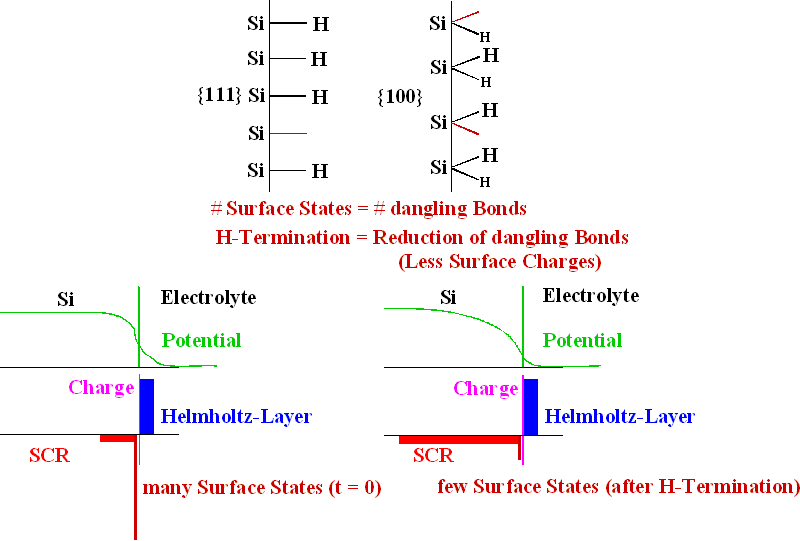 |
|||
| Current-bursts, nucleation, and stable pore-growth | |||
| A first essential feature of the current burst model is that all manifestations of electrode behavior now depend exclusively on when and where current bursts nucleate. Correlation in space is produced by interactions in time which means that the nucleation prob-ability of a current burst depends on what happened before. Since the nucleation probability is larger for smaller degrees of H-passivation, and H-passivation in turn is minimal on the {100} surfaces just after the oxide is removed, there is an automatic coupling of new current bursts to old ones in the "pore regime" (i.e. whenever free Si surface is present) - the interaction in time is an intrinsic feature of the model. Whereas this is a necessary ingredient for the clustering of current bursts and thus the appearance of (meso- or macro) pores; it is not totally sufficient: At low current densities for example, the number of current bursts nucleating per time unit may still be larger somewhere in a large area having a small nucleation probability, compared to the small area around an "old" current burst having a large probability, because the number of current bursts nucleating is probability times area. This allows for micropores, otherwise only macropores would be observed. | |||
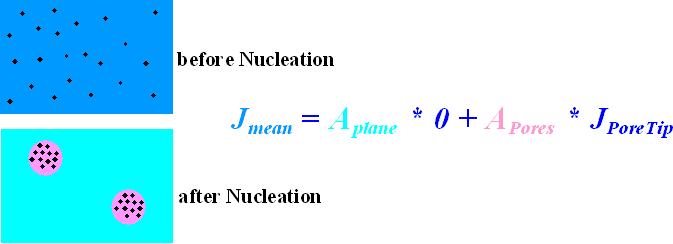 |
|||
| Outlook and Generalization of the modell | |||
| The current-burst-theory can also explain the osciallations at the
i-v-curve. These burst dominates all the electrochemical reactions at the
silicon-electrolyte-interface. See for detail informations for example: - FÖLL, H., CARSTENSEN, J., CHRISTOPHERSEN, M., HASSE, G., A new view of silicon electrochemistry, PSST 2000, Madrid , März 2000 (to be published Phys. Stat. Sol. (a)) - CARSTENSEN, J., CHRISTOPHERSEN, M., HASSE, G., FÖLL, H., Parameter dependence of pore formation in silicon within a model of local current bursts, PSST 2000, Madrid , März 2000. (to be published in Phys. Stat. Sol. (a)) |
|||
| The current burst theorie can be used for an model of all pores etched in hydrofluoric acids solutions - a small introduction. | |||
| The model for the local current burst in the "oscillation regime" (closed oxide layer is present) was devoleped by J. Carstensen, R. Prange, H. Föll (J. Electrochem. Soc.,146, 1134 (1999)). This is the base for the generalization of the current burst model. | |||